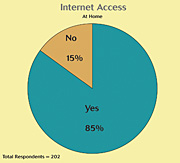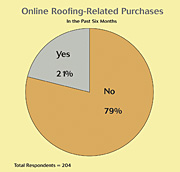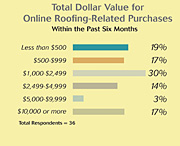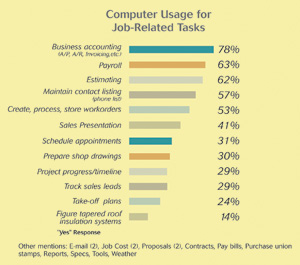
The fact that such a story even needs to be written says something about the speed (or lack thereof) with which roofing contractors have embraced change, but perhaps it is more a function of the industry than with roofers in particular. It makes sense that even the most backward contractor would learn to use business software, but the main business of selling roofs to consumers is still done face-to-face, while buying product is done, for the most part, through distributors. Yet the Internet isn't going away and change, however slow, is good.

Roofers Online
A direct-mail survey was sent to a random sample ofRoofing Contractorsubscribers. Those roofers who responded report that they spend an average of eight hours a week using the Internet for work. Seventy-four percent of them do indeed use the Internet to find information on roofing products and roofing in general, though only 21 percent of them have actually made a roofing-related purchase online. The average dollar amount of such purchases over the last six months is $3,598. The types of items purchased include tools, equipment and rooftop accessories. In addition, 85 percent have Internet access at home.
Surprisingly, as compared to the country as a whole, roofers are actually more wired, in terms of Internet usage. The Pew Internet & American Life Project, which aims to be an authoritative source on the evolution of the Internet, reports that 67 percent of Americans use the Internet. Of those who are online, 91 percent use it to send e-mail, 78 percent use it to research a product before purchase, and 67 use it to actually purchase a product. (For more information, visit www.pewinternet.org)

Software and PDAs
What about internal office functions? Seventy-eight percent of readers surveyed use software for business accounting, 63 percent use it for payroll, 62 percent use it for estimating, and 57 percent use it to maintain a contact database. Other popular uses for software include processing work orders (53 percent) and creating sales presentations (41 percent).
And what about when roofers are out of the office? We didn't even ask about cell phones, but we guess, based on anecdotal evidence, that 110 percent of roofers have mobile phones-and they are always talking on them. But personal digital assistants (a fancy name for a BlackBerry) aren't as popular. A mere 15 percent of roofers have them.

On the Cutting Edge
Should you want to embrace the Internet, there is plenty out there for you. Last summer we reported that MonierLifetile, Irvine, Calif., began offering Web-based order entry for its customers, beginning in February 2004. Users can access an array of online business services through the company's Web site, www.monierlifetile.com. This Direct Order Entry (DOE) was designed to improve efficiency and order accuracy, as well as reduce transaction costs for its customers.We recently reconnected with Donna Baldwin, MonierLifetile's director of customer service, for a progress repot. "We feel that our Web-based Direct Order Entry ... presents a way in which MonierLifetile can participate in growing ... our customers' businesses through streamlining the transaction time and expense in ordering tile roofing products. Customers have been able to take control of the ordering process."
Customers are now able to pick and choose the methods in which they want to place their orders, change the status of their orders, and get updates on their orders. Currently, between 25 to 30 percent of MonierLifetile orders nationwide are placed using the Web-based DOE. "Another 5 to 10 percent of orders nationwide are also accepted electronically through an EDI / XML electronic order transfer system," says Baldwin. "And, those numbers keep increasing monthly."
Approximately 65 percent of MonierLifetile's active customers are using some form of the e-business programs and those customers represent over 90 percent of the company's sales nationally. "The success of the programs have been exponential, as we not only receive but also solicit recommendations for future improvements to even further streamline our customers' business cycles," says Baldwin. "
Since its launch, MonierLifetile has added many features to the My MLT Portal and tries to add one or two major items each quarter. "Just to name a few, under the Sales Order Status section, we have given customers the ability to change the request date on their orders and to cancel line items or whole orders if need be," Baldwin explains. "In the Web Direct Order Entry section, in addition to customers being able to order standard product, we have also given customers the ability to order ‘last call' material (discounted aged material), available for immediate pickup. In early June, we added the ability for customers to order close-out materials (excess discontinued or special production order material)."
Baldwin notes that both of these functions give customers access to hard-to-find material all over the country and to supplement demand when supply is scarce of traditional product offerings. "We also added two new sections to My MLT in which customers get either immediate or regular access to receiving specific MonierLifetile documents and reports to meet the needs of their specific businesses," she continues. "Documents on Demand (DOD) allows customers to request and receive in minutes by e-mail or fax, the five most requested documents-open quote reports, open order reports, open pickup window reports, signed delivery notes and invoices."
On the more virtual side of e-business, in June of 2004, "We launched our first customer on EDI / XML, an electronic transfer of orders from their system to ours. This approach is practical for very large customers with huge volumes of orders. This saves both MonierLifetile and the customer the pains of handling paperwork, entering the order in MonierLifetile's system, and receiving confirmations. We continue to launch this program with large customers across the country to meet their needs."

More Online Options
Jay Butch, director of contractor programs for CertainTeed, Valley Forge, Pa., does not believe that such Web-based ordering will be spreading like wildfire in the roofing universe, though there are many services on manufacturer Web sites to help contractors succeed in business. "[We have] more than you can shake a stick at or everything short of ordering product directly," says Butch. "The CertainTeed Web site offers product specs, product lit and brochures, digital photographs, a continuing education course, installation instructions, online ordering of Business Resources catalog items, online warranty registration and claim kits, information about credential programs, homeowner videos and brochures, contractor locator [for consumers], where to buy products, company information, etc., etc."Butch says that the company is always looking for ways to make more information and services available to its contractors via the Web and add to its offerings as either the need arises or as new materials are developed.
What is his overall assessment of contractors and their Web savvy? "Over the past six years we have monitored roofing contractors' usage of computers, software, the Internet and Web sites," says Butch. "Overall we have seen growing contractor awareness and utilization of technology with the most significant increases occurring in the past two to three years. Nowadays, more and more contractors have a company Web site, use at least one piece of software to help them run their business, use the Internet on a frequent basis-and some are even incorporating downloaded digital photos into a laptop-based sales presentation." As for the future, Butch believes that the use of computer technology will continue to expand in different facets of everyday life and business. "Depending on the size, complexity and business-model of the contractor, there may be certain functions that will be slow to change or that do not readily lend themselves to technology," he says. "As each new generation of contractors come into the business, technological advances will be made more rapidly. There is an inherent resistance to change built into all of us and adopting new technologies is no different. But on the bright side we have seen many contractors from the ‘old-school' make the leap and adapt well. With the pace of change increasing, it seems inevitable that we must grow with the times or hire a ‘young-pup' to keep us up to date."
Jay's advice to contractors? "When you want to learn about new technology, simply ask the closest teenager to give you the lowdown! Why spend 15 minutes trying to figure out how to program your new cell phone when ‘the kid' can do it in five!"
Shawn Stanley, marketing director, IB Roof Systems, Eugene, Ore., agrees that contractors are "getting with the program," so to speak. Although he admits that some are still leery of online procedures, "So they use their office assistants to go online and get info and do various tasks," he says. "We have tried to make our new Web site as easy as possible to navigate and to perform all needed operations."
The new IB Roof site offers technical data, specification preparation, one-page cut specification, downloadable estimation software, up-to-date price list, sample warranties, architectural information, and a full line of sales tools that can be ordered online-albeit via the contractor's sales representative. "We are also working on a customer service section where contractors would be able to go online and view their account, pay their bill, and view their current and past orders," says Stanley. As for expanded offerings, "When more services are needed we will try to supply as many as possible online along with good old fashioned one-on-one customer service."

The Distribution Side
It seems logical that if a contractor were going to be able to buy product directly via the Internet, it would start with the distribution companies. We checked in ABC Supply Co. Inc., Beloit, Wis., to gauge its perception of the changing landscape. The company's Web site currently includes store locations, product listings and links to other sites including its online catalog."It is our intention to continue to expand our Web presence as we learn more from our customers about what they would like to see offered and how it can make their lives easier," says Keith Rozolis, senior vice president of strategic marketing and planning. When asked if there is a demand from contractors to be able to do more via the Web, Rozolis responds, "More contractors are using it, but right now one major use is gathering and capturing information, MSDS sheets, promotion details, order status or product information. We expect that to continue to grow as the Web is a more efficient and effective way to communicate, distribute and deliver this kind of information."
Rozolis believes that contractors are a lot more Web savvy than people give them credit for, "But I also believe that a lot of them haven't incorporated using the Web into their day-to-day business processes," he says. "As appealing as it might sound to have a customer pull out his or her PDA or computer while on the jobsite to check on the status of an order, the fact is that in many cases it is faster and easier to just call us on the phone or fax it in." Over all, "There is no question that the Web is a tremendous communication tool and that its use will continue to grow. At this point, though, it is too early to tell how it will ultimately fit in to our industry."

Lessons from The Cutting Edge
Probably the most shocking result of our survey is that 58 percent of respondents did NOT have a company Web site. Of those that do have Web sites, the most prominent features are company information sections and the ability for customers to request information.There are successful contractors with successful Web sites, however, and they illustrate the benefits of a company presence on the Internet. One example is Wayne Threadgill, president of Threadgill Sheet Metal Works, Cypress, Texas (www.threadgillsheetmetal.com). Founded in 1964, the company specializes in the fabrication and installation of custom residential architectural sheet metal. TSMW has recently gotten into custom-fabricated steel buildings and even composition roofing. The company's first Web site went live in May 1999 and has proven to be a most valuable asset. In January 2001, TSMW launched an e-commerce application that features online ordering for custom-fabricated copper items made-to-order, including copper bay window covers and entry awnings.
At age 45, Threadgill reports that he uses the Internet for work approximately 15 hours per week, including time spent looking for information on roofing and/or roofing products. Only 32.8 percent of contractors we surveyed in the 45-to-54 age bracket spent 10 hours or more per week on the Internet. Threadgill has not made any purchases online, though he says he would like to be able to get online availability, pricing and delivery for coil products.
Threadgill is not surprised that most roofing contractors do not yet have company Web sites. "Construction workers are not often writers and that's the biggest part of the work of putting a successful Web site together-information. Those who do actually have Web sites seldom have professionally prepared Web sites, and they often are graphics intensive with little actual information beyond captions."
It is worth the effort though. "In general Web site leads are the best qualified leads I get," says Threadgill. "If someone calls me about a metal roof after having spent some time on my Web site, they have a very good idea about the different grades and types of roofing products-that means I have to worry less about some other contractor getting the job by submitting a lower bid for lower quality product."
TSMW also sells, via its Web site, "a good number" of the chimney caps, awnings, and other roofing and gutter system accoutrements that provide inside work for rainy days. "Builders are impressed by a professional appearing Web site," Threadgill adds. "I get regular requests from the press to use images or other content from the Web site and thus get free exposure. I could go on but you should be getting the picture."
The Century Slate Co., Durham, N.C., has a similar story (www.centuryslate.com). The company specializes in slate, tile and copper roofing and its president, Mike Tenoever, 35, spends at least 15 to 20 hours a week using the Internet for business purposes. "In addition to searching for information, our business software is an Internet-based software," he explains. "All of our estimates, POs, invoices-everything goes into this software."
Tenoever says he uses the Internet every morning to "check the radar." He also does all of his material research online. "Almost all of the material manufacturers have Web sites [which] are extremely helpful," he says. "You can download all of your specification sheets, data sheets, hazmat data-all of this information is needed for any commercial project that requires submittals of material data. Before the Internet you had to call your material supplier and then wait for them to get the info you needed and fax it over to you. Now, you type in the Web site, click on material specifications and print what you need. There is no waiting! I compare products online from pricing to quality of product. I run searches on more general topics to see what other comparable products are out there in the world. There is no better tool for gathering information than the Internet."
Tenoever has also been able to purchase products online, including all of the company's safety gear, some hand tools, and roof vent systems. "It saves me time by ordering online. I can view a complete list of products and select based on my needs," he says. "Recently, from start to finish, it took me approximately 15 minutes to complete a $1,500 order worth of new safety gear. The gear arrived two to three days later via ground transportation. It would have taken me at least that long to drive to a place that sells safety gear. That place may or may not have a good selection or good pricing. If they did not have what I wanted then I would have to drive somewhere else and so on." On the other hand, "If I wasn't satisfied with the selection of safety gear from the Web site I was at, I could have run a search for another site in a fraction of a second."
From Tenoever's vantage point it seems that almost everything is available online, though maybe not at the best pricing available. "I would like to see the local distributors set up Web sites for purchasing online," he says. "If they had customer logins for different accounts varying customers would be able to access their agreed pricing levels and discounts for certain quantities. Orders could be made at any time-days, nights or weekends. There would be fewer communication breakdowns on material orders if the customer filled out the PO on the vendor's Web site. Orders could be tracked online to see the expected ship date. The faster I can access information, the fewer phone calls I have to make to suppliers, the fewer interruptions in my workday-is all that much better for me. The people portion of the project should be reserved for just that-the project."
If you thought you were behind the times because your company does not have a Web site, try keeping up with Century Slate-it has two sites. "One is an informational Web site the other is for selling products online," says Tenoever. "Our online sales site allows customers to log in and gain access to their price levels. They can see photos of each product with a brief description of its use. The order is automatically calculated with shipping costs, etc. The customer pays with a credit card or account and we are then sent an e-mail with the order information to be filled."
Tenoever says that the Web sites have helped save Century Slate thousands of dollars every month. "Our typical customers tend to be affluent and tend to use the Internet as their research tool. We were able to cut WAY back on our Yellow Pages advertising, which cost thousands of dollars a month. This has been particularly helpful for us because we are a specialty roofing contractor. We only do slate, tile and historical metal roofing. The large ad in the Yellow Pages tended to garner calls from customers who needed work on roofs that we do not work on, such as, shingles, painted steel, commercial flat roofs, etc. [These ads] also attracted the attention of random solicitors."
In addition to gaining new customer interest from the Internet, Century Slate has also been able to use it as a sales tool for customers that have pending proposals. "We are able to show them photos on Web the site of various products and how they might look as a finished product on a roof. The photos can capture any point you are trying to convey," says Tenoever. "You can show detail by using close-up photos or can show large-scale projects with aerial photos or long-distance photos. Photos and descriptions on the Internet can convey the message about your company that you want your customers to know. It adds professionalism, increases customer confidence and helps close the sale."
Report Abusive Comment